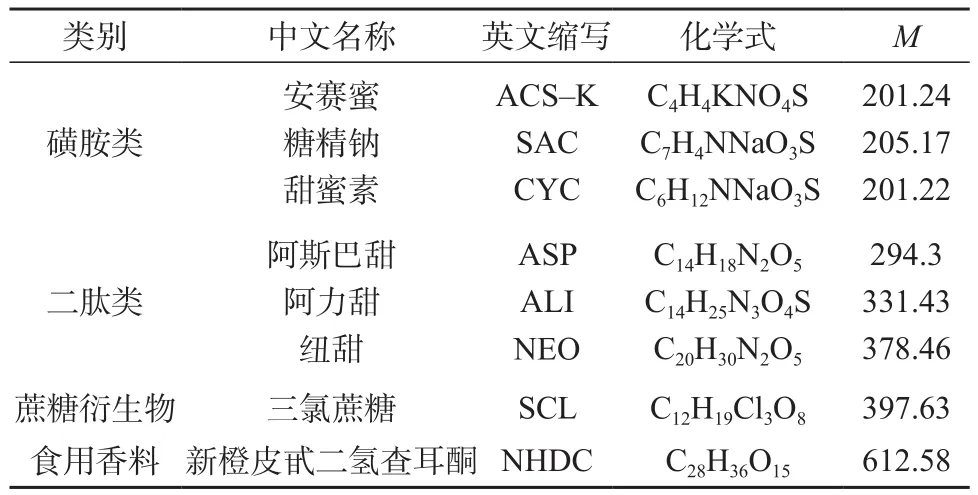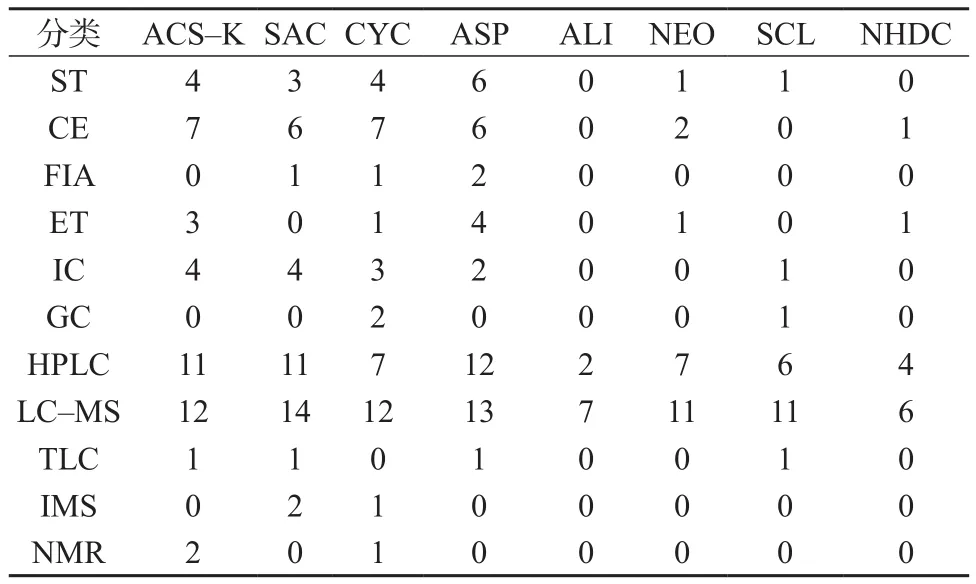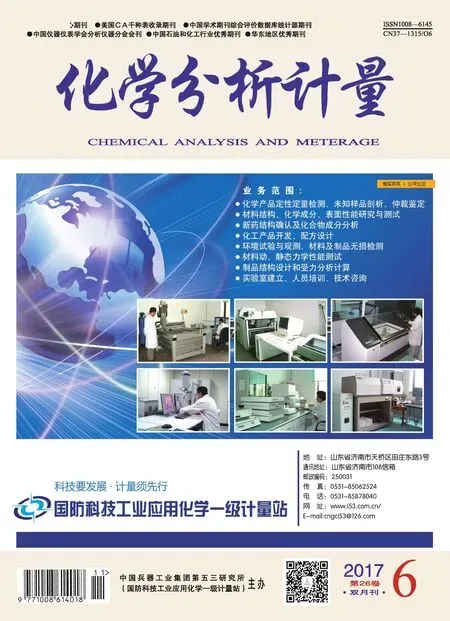合成甜味剂检测技术的研究进展*
武太鹏,马康
(中国计量科学研究院,北京 100013)
合成甜味剂检测技术的研究进展*
武太鹏,马康
(中国计量科学研究院,北京 100013)
综述近十年来食品中合成甜味剂的检测技术。着重介绍光谱法、毛细管电泳法、流动注射分析法、高效液相色谱法以及液相色谱串联质谱法等。结合实际需求,比较不同方法的特点,并对合成甜味剂检测技术的发展进行了展望。
食品;合成甜味剂;检测技术;进展
甜味剂是一类可以增强食品甜味的添加剂,具有甜度高、热量低、不易发生龋齿等优点,应用极为广泛。按其来源分为天然甜味剂和合成甜味剂两种,其中合成甜味剂因其造价低廉,在食品中得到了广泛应用。过度摄入可能出现皮肤问题、头痛、情绪变化、行为变化、呼吸困难、癫痫、过敏甚至癌症等病症,为保证食品安全,急需建立能准确测定食品中合成甜味剂的检测技术。各国对甜味剂的种类、范围、用量均已做出明确的规定[1]。目前我国允许使用的合成甜味剂有8种,其中双甜的应用较少,故不做介绍,其余7种甜味剂根据结构可划分为磺胺类、二肽类、蔗糖衍生物3类。除此之外,食用香料新橙皮苷二氢查耳酮也能够起到增强甜味的作用,在实际生产过程中常被当作甜味剂使用[2]。8种常用合成甜味剂的基本信息见表1。

表1 8种常用的合成甜味剂的基本信息
为确保合成甜味剂在食品中的合理使用,必须对其种类及含量进行准确测定。在实际生产过程中,多种甜味剂常被混合使用,以得到更佳的口感和利益,所以目前对多种甜味剂同时测定的方法较多,同时单一甜味剂的检测技术也在不断的改进。笔者着重介绍和比较了几类目前应用较多的分析方法,并展望了合成甜味剂检测技术的发展。
1 样品处理方法
食品样品基质具有复杂的多变性,极有可能成为干扰因素,影响对甜味剂的准确测定。选择合适的样品处理方法,使基质的影响降到最低,提高灵敏度,获得最佳的检测结果。
目前,在对食品中甜味剂的测定过程中,对样品的前处理主要有超声和过滤、溶剂提取、沉淀、固相萃取等方法[3]。超声和过滤法主要针对基质比较简单的液体样品,通过超声对样品进行脱气处理后过滤,再进行检测[4-6];溶剂提取法主要针对基质比较简单的固体样品,用溶剂从样品中提取甜味剂后,过滤或离心等处理后再检测;沉淀法主要针对含脂肪、蛋白质等大分子的食品,通过加入沉淀剂使甜味剂沉淀,经离心等处理后进行测定;与其它方法相比,固相萃取法使用不同的吸附柱以及洗脱液处理样品,可用于各种食品基质,应用极其广泛,具有操作简单、重现性和兼容性好等优点,是食品前处理最强大的技术之一[7-10]。此外,研究人员还建立了超声乳化微萃取法、固相微萃取法以及分散固相萃取法等应用前景良好的新型前处理技术[11-14]。
2 检测方法
大多数检测方法可实现对多种合成甜味剂的同时测定,但由于检测机理的不同,不同的检测方法适用于不同的甜味剂种类。由于检测条件等因素的限制,一些检测技术的应用相对较少,尤其是针对多种合成甜味剂的同时检测。合成甜味剂的主要检测方法包括紫外分光光度法、拉曼光谱法、红外光谱法、电化学法、毛细管电泳法、流动注射分析法、离子色谱法、气相色谱法、高效液相色谱法、波层色谱法等。
2.1 光谱法
光谱法(ST)是利用待测物对光的反射、折射、散射、吸收等特性对目标分析物进行分析鉴定[15],包括紫外分光光度法,拉曼光谱法和红外光谱法[16-18]。
Idris等[19]建立了一种简单且快速的紫外分光光度法测定SCL,于270 nm处测定SCL在碱性介质(pH 12)中的光降解产物,SCL的线性范围为0.1~1.2 g/L,相关系数为 0.997 7,方法检出限为 0.02 g/L。Llamas等[20]提出了一种基于UV-vis和偏最小二乘法测定SAC和ACS-K的方法,通过移动窗口波长选择最佳的光谱区域,SAC的检出限为0.312 mg/L,ACS-K的检出限为0.085 mg/L,该法被成功应用于速溶果汁粉末中SAC,ACS-K的同时测定。Buyukgoz等[21]开发了一种使用银纳米粒子的表面增强拉曼光谱法测定软饮料中的ASP,相关系数为0.969~0.977,矿泉水的检出限为0.17 mg/mL,定量限为0.56 mg/mL,日内和日间精密度分别为1.3%和0.9%,加标样品的平均回收率为81%~95%,测定结果的相对标准偏差为7.3%(n=4)。该法具有分析时间短、实用性强、样品用量少且无需预处理等优点。Fu等[22]比较了纯甜味剂和酒精样品的拉曼光谱图,对商业酒和葡萄酒中SAC,ACS-K,CYC,ASP,NEO以及甜菊苷6种非法甜味剂进行定性测定,结果表明,该方法快速简单,重复性好,灵敏度高,样品用量少且成本较低。Khurana等[23]通过偏最小二乘回归分析与傅立叶变换红外光谱联用法测定软饮料中的ASP,选择了1 600~1 900 cm-1之间的光谱区域对ASP进行定量测定,测定结果与HPLC法测定结果相比,误差范围为2.4~5.7%。Tosa等[24]使用FT-IR法对混合物中的4种合成甜味剂进行了准确测定,分别通过 1 736,836,2 854,1 050 cm-1 处的峰高和峰面积对ASP,ACS-K,CYC和SAC进行测定,该方法的测定结果与EI-MS法得到的结果一致。Cantarelli等[25]提出了一种测定ASP和ACS-K混合物的新方法,通过对紫外光谱数据建立偏最小二乘多元校正模型测定目标分析物,样品加标回收率为99.2%,测定结果的相对标准偏差为3.2%(n=5)。
2.2 毛细管电泳法
毛细管电泳法(CE)具有操作简单、分离能力强、分辨率高和溶剂消耗低等特点,在合成甜味剂的测定中,毛细管区带电泳(CZE)是使用最多的电泳模式,其次为胶束电动毛细管色谱和毛细管等速电泳[10,26-28]。
Yang等[29]通过一种与电容耦合非接触电导检测相结合的新型毛细管电泳法测定饮料中ACS-K,SAC和CYC 3种磺胺类合成甜味剂,各化合物可在10 min内实现分离,方法检出限为4.4%~8.8 μg/L,测定结果的相对标准偏差为3.0%~5.0%(n=6)。Stojkovic等[30]通过具有非接触电导检测的毛细管电泳法对ASP,CYC,SAC和ACS-K进行测定,可以在3 min内实现4种甜味剂的分离,方法检出限为3.8~6.5 μmol/L。Vistuba等[31]利用CZE建立了一种快速分析食品和药品中ASP,CYC,ACS-K和SAC的方法,采用紫外检测器于220 nm处进行检测,各分析物可在1 min内实现分离,线性相关系数均大于0.997 2,方法检出限为3.3~6.4 mg/L,样品的平均回收率为91%~117%。Perezruiz等[32]通过CZE-DAD法于282 nm波长处消除了其它甜味剂和糖的干扰,准确测定果汁和酸奶等食品中的NHDC,线性范围为2.9~42.0 mg/L,相关系数为0.999 6,方法检出限为1.75 μg/L,日内和日间精密度分别为1.6%和2.8%(n=10)。Herrmannova等[33]采用毛细管等速电泳法-电导检测器同时测定糖果和口香糖中ACS-K,SAC,ASP,CYC 4种合成甜味剂在内的8种甜味剂,可在20 min内完成检测,4种合成甜味剂的检出限不超过0.061 mmol/L,相关系数为0.998 6~0.999 9。Wu等[34]建立了一种胶束电动毛细管色谱法同时测定ALI,ASP,NEO,ACS-K 4种合成甜味剂和其它食品添加剂,ALI和ASP的检出限均为2.5 mg/L,定量限均为7.5 mg/L;NEO的检出限为0.625 mg/L,定量限为1.875 mg/L;ACS-K的检出限为1 mg/L,定量限为3 mg/L;相关系数均大于0.99,样品的回收率为81.6%~115.0%,测定结果的相对标准偏差小于5%(n=5)。
2.3 流动注射分析法
流动注射分析法(FIA)与化学发光法,分光光度法,原子吸收光谱法或传感器法等的联用,极大丰富了其应用范围[35]。FIA是一个功能强大的自动化技术,对样品的处理量高,样品和试剂的消耗低,分析速度快,尤其适用于大量样品中一个或两个分析物的测定。
Radulescu等[36]通过戊二醛将醇氧化酶、羧酸酯和牛血清白蛋白固定在用钴-酞菁改性的丝网印刷电极上开发了一种新型生物传感器,采用流动注射分析食品中的ASP,样品通量为40 h-1,ASP的检出限为0.2 μmol/L,测定结果的相对标准偏差为2.7%(n=10),该方法快速、简单且稳定,不需要任何的预处理过程,该生物传感器成功地应用于不同食品基质中ASP的测定。Rocha等[37]通过FIA系统对CYC进行了快速测定,利用CYC与过量的亚硝酸盐在酸性介质中与碘化物反应,采用分光光度法于350 nm处对反应生成的三碘化离子进行测定,方法检出限为30 μmol/L(置信水平为 99.7%)。Capitán-Vallvey 等[38]通过 FIA 对 SAC和ASP的混合物进行测定,通过C18硅胶微柱分离SAC和ASP,紫外分光光度法先后对SAC(210 nm)和ASP(205 nm)进行测定,该方法的采样频率为10个/h,线性范围分别为 1.0~200.0,10.0~200.0 μg/mL,方法的检出限分别为0.30,1.4 μg/mL,测定结果的相对标准偏差分别为1.0%,1.6%(n=10),样品的加标回收率为99%~101%,该方法准确测定了糖果和饮料中ASP和SAC的含量。
2.4 电化学法
电化学法(ET)具有简单、快速、成本低以及样品无需前处理等优点,一些基于修饰电极的电化学法已被用于分析食品中的合成甜味剂[39-40]。
Deroco等[41]使用掺杂硼的金刚石电极-差分脉冲伏安法实现了对食品中的ASP和ACS-K的同时检测,检出限分别为 1.60,280 μmol/L。Pierini等[42]提出了一种同时测定ACS-K和ASP的方法,采用多元校准工具辅助的线性扫描伏安法,结合旋转圆盘电极来提高方法灵敏度。该方法的样品通过量为90个/h,且分析结果与标准值基本一致。Medeiros等[43]利用金刚石电极建立了一种方波伏安法同时测定食品中ASP和CYC,该方法能将混合物中ASP和CYC的氧化峰电位分开约400 mV,测定结果与标准值一致,可用于测定几类产品中的ASP。Yang等[44]通过一种基于单壁碳纳米管修饰玻璃碳电极的新型伏安传感器测定饮料中的 NHDC,线性范围为 5×10-8~8×10-6mol/L,方法检出限为2×10-8mol/L,该方法能准确测定饮料中的NHDC。
2.5 离子色谱法
离子色谱法(IC)主要通过电导检测器、紫外检测器以及质谱检测器检测,具有选择性好、抗干扰能力强且使用有毒溶剂少等优点。
Zhu等[45]通过离子色谱法与抑制电导检测器对食品中ASP,CYC,ACS-K和SAC进行分离和测定,该方法的检出限为0.019~0.870 mg/L,样品的加标回收率分别为97.96%~105.42%。浮潇洋等[46]建立了离子交换-电导检测离子色谱法同时测定饮料中CYC,ACS-K和SAC的含量,该方法的线性范围广且相关系数均大于0.999,方法检出限为0.4~2.0 μg/ml,测定结果的相对标准偏差为0.29%~2.96%(n=6),样品加标回收率为97.2%~102.0%。Chen等[47]提出了一种新的离子色谱法同时测定各类食品中的SAC,ASP,ACS-K及其它添加剂,SAC和ACS-K的检出限均为20 ng/mL,ASP的检出限为30 ng/mL,加标样品的平均回收率为85%~104%。Gui等[48]建立了固相萃取-离子色谱三重四极杆质谱法同时测定水样中ACS-K,CYC,SAC和SCL 4种合成甜味剂,该方法在9 min内便可实现分离,方法检出限为1.7~12.5 ng/L,测定结果的相对标准偏差为2.9%~6.1%(n=7)。
2.6 气相色谱法
气相色谱法(GC)是利用物质固有的沸点、极性以及吸附性差异实现混合成分的分离和测定,该法具有分离效率高、检出限低、灵敏度高、选择性好、成本低以及技术与设备成熟等优点[49]。但甜味剂必须转化为挥发性化合物后才可使用气相色谱法分析,所以该方法的使用并不常见。
Yu等[50]通过气相色谱-电子捕获法对食品中的CYC实现了快速测定,首先将CYC与次氯酸钠在酸性条件下反应转化为N,N-二氯环己胺,再用正己烷萃取后测定,CYC质量浓度在5~250 mg/L线性范围内相关系数为0.999 3,黄葡萄酒和果汁中CYC检出限为0.05 mg/L,定量限为0.2 mg/L;蛋糕和果脯中CYC的检出限为0.25 mg/kg,定量限为0.8 mg/kg,测定结果的日内和日间精密度分别为0.28%和1.1%(n=5),该方法适用于食品中甜蜜素的安全检查和质量控制。黄志勇等[51]建立了一种乙酸酐衍生GC-ECD 法测定饮料中的 SCL,该衍生物为 4,1’,6’-三氯 -2,3,6,3’,4’-五乙酰基蔗糖,其质量浓度在 0.02~1.2 mg/mL线性范围内相关系数为0.999 4,方法检出限为0.23 mg/kg,样品回收率为90.0%~94.5%,测定结果的相对标准偏差为0.6%~2.5%。Hashemi等[52]建立了一种GC-FID法测定CYC,基于CYC和亚硝酸盐在酸性介质中的反应以及对环己烯的微量提取与测定,在30~1 000 μmol/L的范围内线性相关系数为0.999 2,方法检出限为5 μmol/L,样品加标回收率为97%,该法可用于饮料和甜味剂片中CYC的测定。
2.7 高效液相色谱法
高效液相色谱法(HPLC)是测定合成甜味剂最受欢迎的方法之一,紫外检测器(UV)、二极管阵列检测器(DAD)、荧光检测器(FLD)、蒸发光散射检测器(ELSD)、电雾式检测器(CAD)等各种检测器与液相色谱联用,使液相色谱法被广泛应用[53-57]。
Kumari等[58]建立了一种与SPE联用的HPLC-PDA法对蛋糕和冰淇淋中的NEO进行了准确测定,样品加标回收率为96.08%~98.62%,测定结果的相对标准偏差为0.85%~2.85%(n=6),该方法可准确测定不同储存条件下蛋糕和冰淇淋中的NEO。Pane[59]等通过HPLC-DAD法准确测定了多种食品中的ACS-K,SAC,CYC,ASP和NEO,该方法检出限为 0.1~18 μg/mL。Choi等[60]开发了一种使用反相高效液相色谱与间接可见光度法联用测定食品中的CYC,方法检出限为0.14 mmol/L,测定结果的相对标准偏差为0.58%(n=8),样品加标回收率为93%~99%。Bruno等[61]通过HPLC-FLD法测定非酒精饮料中的SAC,有效地消除了基质干扰,其激发波长为250 nm,发射波长为440 nm,方法检出限为4.4 μg/mL,样品加标回收率为98.5%~101.4%。Wasik等[62]通过固相萃取与HPLC-ELSD联用法同时测定饮料、水果罐头和酸奶中ACS-K,ALI,ASP,NEO,NHDC,SAC和SCL等9种甜味剂,在最大可用剂量附近,样品加标回收率为93%~109%,浓度水平接近检测时,测定结果的标准偏差小于5%(n=6),除甘素外其它基质的检出限均低于15 μg/g,定量限均低于30 μg/g。Grembecka等[63]建立了一种新型的HPLC-CAD-UV/DAD法同时测定食品中ASP,ACS-K和SAC等5种食品添加剂,该方法样品加标回收率为98.1%~101%,测定结果的标准偏差为0.11%~1.73%(n=3)。Sik等[64]开发了一种绿色的高效液相色谱法测定软饮料中的ACS-K,SAC,ASP以及咖啡因,该方法不使用有毒的有机溶剂,可在15 min内实现最佳分离,分别于225,217,217 nm波长处进行检测,相关系数不小于0.999,方法检出限为0.011~0.024 mg/L,测定结果的标准偏差为0.44%~1.61%(n=6)。
2.8 液相色谱-质谱联用法
液相色谱-质谱联用法(LC-MS)具有选择性好且灵敏度高等优点,能够提供目标分析物相对分子质量和结构等信息,在合成甜味剂的测定中有着广泛的应用[4-9]。
Kubica等[65]建立了 HPLC-ESI-MS/MS法同时测定饮料中的 ACS-K,SAC,CYC,ASP,SCL,ALI,NHDC 和NEO,仅需对样品进行简单稀释和离心便可进行检测,该方法检出限为1.08~4.52 ng/mL,样品的平均加标回收率为97.0%~105.7%,测定结果的相对标准偏差小于4.1%(n=6)。Shah等[66]通 过 UHPLC-MS/MS法 同 时 测 定 食 品 中14种甜味剂,在多反应监测模式下,该方法的检出限为0.1~2.5 ng/g,测定结果的相对标准偏差为1%~13%(n=6)。Ordonez等[67]开发了一种新型的高温液相色谱-串联质谱法测定各种饮料中 ACS-K,SAC,CYC,ASP,SCL,ALI,NHDC,NEO和甜菊苷9种高强度甜味剂,23 min内可完成检测,方法检出限为0.05~10 mg/L,样品的加标回收率 为 86%~110%。Lim 等[68]通 过 HPLC-MS/MS法 同时测定进口食品中 ACS-K,SAC,CYC,ASP,SCL,ALI,NHDC,NEO以及甘素,相关系数均大于0.99,方法检出限为 0.001~0.375 mg/mL,定量限为0.003~1.125 mg/mL,样品加标回收率为90.0%~107.5%。Ma等[69]建立了超高效液相色谱串联质谱法测定ACS-K,CYC和SAC等8种水溶性食品添加剂,3种合成甜味剂的检出限为0.01~0.2 μg/L,样品加标回收率为93.8%~103.1%,该法可用于来自不同产地红葡萄酒分析。Zygler等[70]建立了高效液相色谱-质谱法同时测定ACS-K,ASP,ALI,CYC,NHDC,NEO,SAC,SCL和甘素,该方法检出限低于0.25 μg/mL,定量限低于2.5 μg/mL,样品加标回收率为84.2%~106.7%,测定结果的相对标准偏差小于10%(n=9),该方法已成功应用于饮料、酸奶和鱼制品中9种甜味剂的测定。
2.9 其它方法
目前对合成甜味的检测中,由于技术条件和检测效果等原因,存在一些应用范围较小的检测技术,如薄层色谱法 (TLC)[71-72]、离子迁移色谱法 (IMS)[73-74]、核磁共振技术(NMR)[75-76]等。
3 展望
近十年来合成甜味剂的检测方法的使用情况见表2。由表2可知,一些历史较长、应用范围广泛的甜味剂如ACS-K,SAC,CYC和ASP等,几乎可以通过目前所有常见的检测方法进行测定,而针对NHDC,ALI和NEO等合成甜味剂的检测技术和文章比较少。

表2 近十年合成甜味剂的检测方法的使用情况 数量/篇
由于合成甜味剂多组分分析的能力以及甜味剂理化性能的兼容性、灵敏性和稳定性,HPLC和LC-MS法成为了应用最为广泛的方法,是分析人员的首选方法;CE和IC法分辨能力好,运行成本较低,在一些检测中成为替代高效液相色谱法的有效分析方法,但由于稳定性的欠缺使其应用受到了限制。在许多情况下合成甜味剂的分析也可以通过电化学技术、光谱技术或FIA来进行,这几种技术的灵敏度、选择性都可满足相关要求,但仅适用于一种或几种甜味剂的测定,具有一定局限性;TLC法分离效率低,GC法需要耗费大量的时间和人力进行衍生化,因而这两种方法的应用极少;NMR和IMS由于技术条件等因素的限制,相关应用较少。随着技术的发展,对食品中合成甜味剂的检测必将朝着更加简单、稳定、快速、低成本且可靠的方向发展。
[1]Zygler A, Wasik A, Namiesnik J. Analytical methodologies for determination of artificial sweeteners in foodstuffs[J]. Trac Trends in Analytical Chemistry, 2009, 28(9): 1 082-1 102.
[2]GB 2760-2014 食品安全国家标准食品添加剂使用标准[S].
[3]王栩冬,渠志华,李明元,等.食品甜味剂测定中样品前处理技术研究进展[J].中国卫生检验杂志,2007,17(3): 564-565.
[4]Yang D J, Chen B. Simultaneous determination of nonnutritive sweeteners in foods by HPLC/ESI-MS[J]. Journal of Agricultural amp; Food Chemistry, 2009, 57(8): 3 022-3 027.
[5]Chang C S, Tai S Y. Detection of 10 sweeteners in various foods by liquid chromatography/tandem mass spectrometry[J]. Journal of Food amp; Drug Analysis, 2014, 22(3): 318-328.
[6]Lorenzo R A, Pena M T, Fernandez P, et al. Artificial sweeteners in beverages by ultra performance liquid chromatography with photodiode array and liquid chromatography tandem mass spectrometry[J]. Food Control, 2015, 47: 43-52.
[7]Gao H,Yang M L, Wang M L, et al. Determination of 30 synthetic food additives in soft drinks by HPLC/electrospray ionizationtandem mass spectrometry[J]. Journal of Aoac International,2013, 96(1): 110-115.
[8]Sakai H, Yamashita A, Tamura M, et al. Simultaneous determination of sweeteners in beverages by LC-MS/MS[J]. Food Addit Contam Part A Chem Anal Control Expo Risk Assess, 2015, 32(6):808-816.
[9]Ferrer I, Thurman E M. Analysis of sucralose and other sweeteners in water and beverage samples by liquid chromatography/time-offlight mass spectrometry[J]. Journal of Chromatography A, 2010,1 217(25): 4 127-4 134.
[10]Horie M, Ishikawa F, Oishi M, et al. Rapid determination of cyclamate in foods by solid-phase extraction and capillary electrophoresis[J]. Journal of Chromatography A, 2007,1 154(1-2): 423-428.
[11]Hashemi M, Zohrabi P, Abdolhosseini S. Spectrophotometric determination of cyclamate in artificial sweeteners and beverages after ultrasound-assisted emulsification microextraction[J].Analytical Methods,2015,7(6): 2 594-2 602.
[12]Moein M M, Javanbakht M, Karimi M, et al. Molecularly imprinted sol-gel nanofibers based solid phase microextraction coupled on-line with high performance liquid chromatography for selective determination of acesulfame[J]. Talanta,2015,134:340-347.
[13]Zhao Y G, Cai M Q, Chen X H, et al. Analysis of nine food additives in wine by dispersive solid-phase extraction and reversed-phase high performance liquid chromatography[J].Food Research International,2013,52(1): 350-358.
[14]Chen X H, Zhao Y G, Shen H Y, et al. Application of dispersive solid-phase extraction and ultra-fast liquid chromatographytandem quadrupole mass spectrometry in food additive residue analysis of red wine[J]. Journal of Chromatography A, 2012,1 263(21): 34-42.
[15]武太鹏,马康.无损快速检测技术在生鲜食品品质鉴定中的应用[J].食品质量安全检测学报,2017,8(3): 729-736.
[16]Aguilar-Arteaga K, Jesus-Fuentes K I D, Contreras-Lopez E, et al. Determination of cyclamate by a cheap and simple spectrophotometric method[J]. Journal of Food Measurement amp;Characterization, 2017,11(2): 1-8.
[17]Mazurek S, Szostak R. Quantification of aspartame in commercial sweeteners by FT-Raman spectroscopy[J]. Food Chemistry,2011, 125(3): 1 051-1 057.
[18]Armenta S, Salvador Garrigues A, Guardia M D L. FTIR determination of aspartame and acesulfame-K in tabletop sweeteners[J]. Journal of Agricultural amp; Food Chemistry, 2004,52(26): 7 798-7 803.
[19]Idris M, Rao V J, Middha D, et al. Determination of sucralose by controlled UV photodegradation followed by UV spectrophotometry[J]. Journal of Aoac International, 2013,96(3): 603-606.
[20]Llamas N E, Nezio M S D, Palomeque M E, et al. Direct determination of saccharin and acesulfame-K in sweeteners and fruit juices powders[J]. Food Analytical Methods, 2008, 1(1):43-48.
[21]Buyukgoz G G, Bozkurt A G, Akgul N B, et al. Spectroscopic detection of aspartame in soft drinks by surface-enhanced Raman spectroscopy[J]. European Food Research and Technology,2015, 240(3): 567-575.
[22]Fu D Y, Yuan D, Zhang X F, et al. Fast Detection of illegal sweeteners in liquor and wine by laser raman spectroscopy[J].Advanced Materials Research, 2014, 960-961: 32-38.
[23]Khurana H K, Cho I K, Shim J Y, et al. Application of multibounce attenuated total reflectance fourier transform infrared spectroscopy and chemometrics for determination of aspartame in soft drinks[J]. Journal of Agricultural amp; Food Chemistry, 2008, 56(3):778-783.
[24]Tosa N,Moldovan Z, Bratu I. Simultaneous determination of some artificial sweeteners in ternary formulations by FT-IR and EI-MS[J]. Talanta, 2012, 1 425(1): 98-101.
[25]Cantarelli M A, Pellerano R G, Marchevsky E J, et al.Simultaneous determination of aspartame and acesulfame-K by molecular absorption spectrophotometry using multivariate calibration and validation by high performance liquid chromatography[J]. Food Chemistry, 2009, 115(3): 1 128-1 132.
[26]Hu F, Xu L, Luan F, et al. Determination of neotame in nonalcoholic beverage by capillary zone electrophoresis[J]. Journal of the Science of Food amp; Agriculture, 2013, 93(13): 3 334-3 338.
[27]Silva J A F D, Castro N V D, Jesus D P D, et al. Simultaneous determination of aspartame, cyclamate, saccharin and acesulfame-K in soft drinks and tabletop sweetener formulations by capillary electrophoresis with capacitively coupled contactless conductivity detection[J]. Food Chemistry, 2011, 124(4):1 714-1 717.
[28]Fernandes V N O, Fernandes L B, Vasconcellos J P, et al.Simultaneous analysis of aspartame, cyclamate, saccharin and acesulfame-K by CZE under UV detection[J]. Analytical Methods, 2013, 5(6): 1 524-1 532.
[29]Yang L R, Zhou S J, Xiao Y Z, et al. Sensitive simultaneous determination of three sulfanilamide artificial sweeters by capillary electrophoresis with on-line preconcentration and contactless conductivity detection[J]. Food Chemistry, 2015, 188: 446-451.
[30]Stojkovic M, Mai T D, Hauser P C. Determination of artificial sweeteners by capillary electrophoresis with contactless conductivity detection optimized by hydrodynamic pumping[J].Analytica Chimica Acta, 2013, 787(13): 254-259.
[31]Vistuba J P, Dolzan M D, Vitali L, et al. Sub-minute method for simultaneous determination of aspartame, cyclamate,acesulfame-K and saccharin in food and pharmaceutical samples by capillary zone electrophoresis[J]. Journal of Chromatography A, 2015, 1 396: 148-152.
[32]Perezruiz T, Martinezlozano C, Tomas V, et al. Quantitative assay for neohesperidin dihydrochalcone in foodstuffs by capillary electrophoresis[J]. Chromatographia, 2000, 51(7): 385-389.
[33]Herrmannova M, Krivankova L, Bartos M, et al. Direct simultaneous determination of eight sweeteners in foods by capillary isotachophoresis[J]. Journal of Separation Science,2006, 29(8): 1 132-1 137.
[34]Wu Y C,Li J, Zhao S, et al. Simultaneous determination of 11 food additives by micellar electrokinetic capillary chromatography[J]. Food Analytical Methods, 2016, 9(3): 589-595.
[35]高志贤,晋晓勇,房彦军.流动注射分析技术及其在食品分析中的应用[J].卫生研究,2003,32(1): 78-80.
[36]Radulescu M C, Bucur B, Bucur M P, et al. Bienzymatic biosensor for rapid detection of aspartame by flow injection analysis[J].Sensors, 2014, 14(1): 1 028-1 038.
[37]Rocha F R P, Rodenas-Torralba E, Angel Morales-Rubio, et al. A clean method for flow injection spectrophotometric determination of cyclamate in table sweeteners[J]. Analytica Chimica Acta,2005, 547(2): 204-208.
[38]Capitan-Vallvey L F, Valencia M C, Nicolas E A, et al. Resolution of an intense sweetener mixture by use of a flow injection sensor with online solid-phase extraction[J]. Analytical and Bioanalytical Chemistry, 2006, 385(2): 385-391.
[39]Bathinapatla A, Kanchi S, Singh P, et al. Fabrication of copper nanoparticles decorated multiwalled carbon nanotubes as a high performance electrochemical sensor for the detection of neotame[J]. Biosensors amp; Bioelectronics, 2015, 67: 200-207.
[40]Herzog G, Kam V, Berduque A, et al. Detection of food additives by voltammetry at the liquid-liquid interface[J]. Journal of Agricultural amp; Food Chemistry, 2008, 56(12): 4 304-4 310.
[41]Deroco P B, Medeiros R A, Rocha-Filho R C, et al. Simultaneous voltammetric determination of aspartame and acesulfame-K in food products using an anodically pretreated boron-doped diamond electrode[J]. Analytical Methods, 2015, 7(5): 2 135-2 140.
[42]Pierini G D, Llamas N E, Fragoso W D, et al. Simultaneous determination of acesulfame-K and aspartame using linear sweep voltammetry and multivariate calibration[J]. Microchemical Journal, 2013, 106(1): 347-350.
[43]Medeiros R A, Carvalho A E D, Rocha-Filho R C, et al.Simultaneous square-wave voltammetric determination of aspartame and cyclamate using a boron-doped diamond electrode[J]. Talanta, 2008, 76(3): 685-689.
[44]Yang L X, Wang L, Li K J, et al. Sensitive voltammetric determination of neohesperidin dihydrochalcone based on SWNTs modified glassy carbon electrode[J]. Analytical Methods, 2014,6(23): 9 410-9 418.
[45]Zhu Y, Guo Y Y, Ye M L, et al. Separation and simultaneous determination of four artificial sweeteners in food and beverages by ion chromatography [J]. Journal of Chromatography A, 2005,1 085(1): 143-146.
[46]浮潇洋,张焱,王爱月.离子色谱法测定饮料中的几种甜味剂[J].中国卫生检验杂志,2017,27(2): 172-173.
[47]Chen Q C, Wang J. Simultaneous determination of artificial sweeteners,preservatives, caffeine, theobromine and theophylline in food and pharmaceutical preparations by ion chromatography[J]. Journal of Chromatography A, 2001, 937(1-2): 57-64.
[48]Gui J Y, Wei S, Zhang C L, et al. An innovative approach to sensitive artificial sweeteners analysis by ion chromatographytriple quadrupole mass spectrometry[J]. Chinese Journal of Analytical Chemistry, 2016, 44(3): 361-366.
[49]胡光辉,刘伟丽,钱冲,等.气相色谱技术在食品安全检测中的应用[J].食品安全质量检测学报,2016,7(11): 4 312-4 317.
[50]Yu S B, Zhu B H, Lv F, et al. Rapid analysis of cyclamate in foods and beverages by gas chromatography-electron capture detector(GC-ECD)[J]. Food Chemistry, 2012, 134(4): 2 424-2 429.
[51]黄志勇,陈艳,冯慧,等.乙酸酐衍生GC-ECD法测定饮料中三氯蔗糖含量[J].食品科学,2016,37(14): 203-206.
[52]Hashemi M, Habibi A, Jahanshahi N. Determination of cyclamate in artificial sweeteners and beverages using headspace singledrop microextraction and gas chromatography flame-ionisation detection[J]. Food Chemistry, 2011, 124(3): 1 258-1 263.
[53]Croitoru M D, Fulop I, Ajtay M K, et al. Direct HPLC-UV determination of cyclamate, saccharine and aspartame from soft drinks[J]. Acta Alimentaria, 2011, 40(4): 459-465.
[54]Yan W W, Wang N N, Zhang P M, et al. Simultaneous determination of sucralose and related compounds by highperformance liquid chromatography with evaporative light scattering detection[J]. Food Chemistry, 2016, 204: 358-364.
[55]Lee Y, Do B, Lee G, et al. Simultaneous determination of sodium saccharin,aspartame,acesulfame-K and sucralose in food consumed in Korea using high-performance liquid chromatography and evaporative light-scattering detection[J].Food Additives amp; Contaminants Part A Chemistry Analysis Control Exposure amp; Risk Assessment, 2017,34(5): 666-677.
[56]Buchgraber M, Wasik A. Determination of nine intense sweeteners in foodstuffs by high-performance liquid chromatography and evaporative light-scattering detection: interlaboratory study[J].Journal of Aoac International, 2008, 92(1): 208-222.
[57]Liu T H, Jiang Z T, Li R, et al. Simultaneous determination of cyclamate, acesulfame, and aspartame in beverages by titaniabased RP-HPLC[J]. Food Analytical Methods, 2014, 7(7):1 400-1 406.
[58]Kumari A, Arora S, Singh A K, et al. Development of an analytical method for estimation of neotame in cake and ice cream[J].LWT-Food Science and Technology, 2016, 70: 142-147.
[59]Pane D D Q, Dias C B, Meinhart A D, et al. Evaluation of the sweetener content in diet/light/zero foods and drinks by HPLCDAD[J]. Journal of Food Science and Technology, 2015,52(11): 6 900-6 913.
[60]Choi M M F, Meiying H, Siulan W. Determination of cyclamate in low-calorie foods by high-performance liquid chromatography with indirect visible photometry[J]. The Analyst, 2000, 125(1):217-220.
[61]Bruno S N F, Cardoso C R, Maciel M M A, et al. Selective identification and quantification of saccharin by liquid chromatography and fluorescence detection[J]. Food Chemistry,2014, 159(6): 309-315.
[62]Wasik A, Mccourt J, Buchgraber M. Simultaneous determination of nine intense sweeteners in foodstuffs by high performance liquid chromatography and evaporative light scattering detection--development and single-laboratory validation[J]. Journal of Chromatography A, 2007, 1 157(1-2): 187-196.
[63]Grembecka M, Baran P, Blazewicz A, et al. Simultaneous determination of aspartame, acesulfame-K, saccharin, citric acid and sodium benzoate in various food products using HPLC-CADUV/DAD[J]. European Food Research and Technology, 2014,238(3): 357-365.
[64]Sik B. Development and validation of a green high performance liquid chromatographic method for the determination of some artificial sweeteners and caffeine in soft drinks[J]. Food Analytical Methods, 2012, 5(6): 1 443-1 452.
[65]Kubica P, Namiesnik J, Wasik A. Determination of eight artificial sweeteners and common Stevia rebaudiana glycosides in nonalcoholic and alcoholic beverages by reversed-phase liquid chromatography coupled with tandem mass spectrometry[J]. Analytical and Bioanalytical Chemistry, 2015, 407(5):1 505-1 512.
[66]Shah R, Farris S, De Jager L S, et al. A novel method for the simultaneous determination of fourteen sweeteners of regulatory interest using UHPLC-MS/MS[J]. Food Additives amp;Contaminants Part A Chemistry Analysis Control Exposure amp;Risk Assessment, 2014, 32(2): 141-151.
[67]Ordonez E Y, Rodil R, Quintana J B, et al. Determination of artificial sweeteners in beverages with green mobile phases and high temperature liquid chromatography-tandem mass spectrometry[J]. Food Chemistry, 2015, 169: 162-168.
[68]Lim H S, Park S K, Kwak I S, et al. HPLC-MS/MS analysis of 9 artificial sweeteners in imported foods[J]. Food Science and Biotechnology, 2013, 22(1): 233-240.
[69]Ma K, Li X J, Wang H F, et al. Rapid and sensitive method for the determination of eight food additives in red wine by ultraperformance liquid chromatography tandem mass spectrometry[J]. Food Analytical Methods, 2015, 8(1): 203-212.
[70]Zygler A, Wasik A, Kot-Wasik A, et al. Determination of nine high-intensity sweeteners in various foods by high-performance liquid chromatography with mass spectrometric detection[J]. Analytical and Bioanalytical Chemistry, 2011, 400(7):2 159-2 172.
[71]George V, Arora S, Wadhwa B K, et al. Analysis of multiple sweeteners and their degradation products in lassi by HPLC and HPTLC plates[J]. Journal of Food Science and Technology,2010, 47(4): 408-413.
[72]Bernd Spangenberg, Jorg Stroka, Isabel Arranz, et al. A simple and reliable HPTLC method for the quantification of the intense sweetener sucralose®[J]. Journal of Liquid Chromatography amp;Related Technologies, 2003, 26(16): 2 729-2 739.
[73]Midey A J, Camacho A, Sampathkumaran J, et al. Highperformance ion mobility spectrometry with direct electrospray ionization (ESI-HPIMS) for the detection of additives and contaminants in food[J]. Analytica Chimica Acta, 2013, 804:197-206.
[74]张志刚,方恩华,郝玉蕾,等.离子迁移谱法测定饮料中的糖精钠和痕量马来酸[J].食品安全质量检测学报,2015,6(6):2 151-2 156.
[75]毛桂洁,于喆英,历荣.1H-NMR法测定饮料中安赛蜜和甜蜜素的含量[J].黑龙江大学自然科学学报,2012,29(1): 90-94.
[76]Ohtsuki T, Sato K, Abe Y, et al. Quantification of acesulfame potassium in processed foods by quantitative1H NMR[J].Talanta, 2015, 131: 712-718.
Research Development of Detection Technology of Synthetic Sweetener
Wu Taipeng, Ma Kang
(National Institute of Metrology of China, Beijing 100013, China)
Detection technologies of synthetic sweeteners in foods over the past 10 years were reviewed. The methods of detection of synthetic sweeteners were introduced emphatically, such as spectrometry, capillary electrophoresis,flow injection analysis, high performance liquid chromatography and liquid chromatography tandem mass spectrometry,etc. Combined with the actual demand, the characteristics of different methods were compared, and the development of detection technologies for synthetic sweeteners was prospected.
food; synthetic sweetener; detection technology; development
O657 文献标识码:A 文章编号:1008-6145(2017)06-0109-07
10.3969/j.issn.1008-6145.2017.06.027
*国家科技支撑项目(2015BAK45B01)
联系人:武太鹏;E-mail: 25417446@qq.com
2017-09-22

